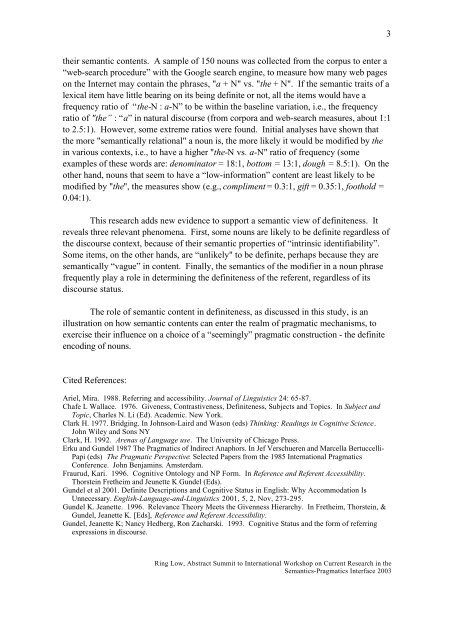SemPrag03.Progr.pdf - Institut für Linguistik/Germanistik - Universität ...
SemPrag03.Progr.pdf - Institut für Linguistik/Germanistik - Universität ...
SemPrag03.Progr.pdf - Institut für Linguistik/Germanistik - Universität ...
You also want an ePaper? Increase the reach of your titles
YUMPU automatically turns print PDFs into web optimized ePapers that Google loves.
3<br />
their semantic contents. A sample of 150 nouns was collected from the corpus to enter a<br />
“web-search procedure” with the Google search engine, to measure how many web pages<br />
on the Internet may contain the phrases, "a + N" vs. "the + N". If the semantic traits of a<br />
lexical item have little bearing on its being definite or not, all the items would have a<br />
frequency ratio of “the-N : a-N” to be within the baseline variation, i.e., the frequency<br />
ratio of "the” : “a” in natural discourse (from corpora and web-search measures, about 1:1<br />
to 2.5:1). However, some extreme ratios were found. Initial analyses have shown that<br />
the more "semantically relational" a noun is, the more likely it would be modified by the<br />
in various contexts, i.e., to have a higher "the-N vs. a-N" ratio of frequency (some<br />
examples of these words are: denominator = 18:1, bottom = 13:1, dough = 8.5:1). On the<br />
other hand, nouns that seem to have a “low-information” content are least likely to be<br />
modified by "the", the measures show (e.g., compliment = 0.3:1, gift = 0.35:1, foothold =<br />
0.04:1).<br />
This research adds new evidence to support a semantic view of definiteness. It<br />
reveals three relevant phenomena. First, some nouns are likely to be definite regardless of<br />
the discourse context, because of their semantic properties of “intrinsic identifiability”.<br />
Some items, on the other hands, are “unlikely" to be definite, perhaps because they are<br />
semantically “vague” in content. Finally, the semantics of the modifier in a noun phrase<br />
frequently play a role in determining the definiteness of the referent, regardless of its<br />
discourse status.<br />
The role of semantic content in definiteness, as discussed in this study, is an<br />
illustration on how semantic contents can enter the realm of pragmatic mechanisms, to<br />
exercise their influence on a choice of a “seemingly” pragmatic construction - the definite<br />
encoding of nouns.<br />
Cited References:<br />
Ariel, Mira. 1988. Referring and accessibility. Journal of Linguistics 24: 65-87.<br />
Chafe L Wallace. 1976. Giveness, Contrastiveness, Definiteness, Subjects and Topics. In Subject and<br />
Topic, Charles N. Li (Ed). Academic. New York.<br />
Clark H. 1977. Bridging. In Johnson-Laird and Wason (eds) Thinking: Readings in Cognitive Science.<br />
John Wiley and Sons NY<br />
Clark, H. 1992. Arenas of Language use. The University of Chicago Press.<br />
Erku and Gundel 1987 The Pragmatics of Indirect Anaphors. In Jef Verschueren and Marcella Bertuccelli-<br />
Papi (eds) The Pragmatic Perspective: Selected Papers from the 1985 International Pragmatics<br />
Conference. John Benjamins. Amsterdam.<br />
Fraurud, Kari. 1996. Cognitive Ontology and NP Form. In Reference and Referent Accessibility.<br />
Thorstein Fretheim and Jeunette K Gundel (Eds).<br />
Gundel et al 2001. Definite Descriptions and Cognitive Status in English: Why Accommodation Is<br />
Unnecessary. English-Language-and-Linguistics 2001, 5, 2, Nov, 273-295.<br />
Gundel K. Jeanette. 1996. Relevance Theory Meets the Givenness Hierarchy. In Fretheim, Thorstein, &<br />
Gundel, Jeanette K. [Eds], Reference and Referent Accessibility.<br />
Gundel, Jeanette K; Nancy Hedberg, Ron Zacharski. 1993. Cognitive Status and the form of referring<br />
expressions in discourse.<br />
Ring Low, Abstract Summit to International Workshop on Current Research in the<br />
Semantics-Pragmatics Interface 2003

















